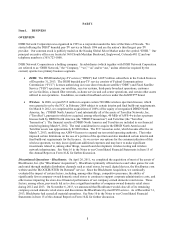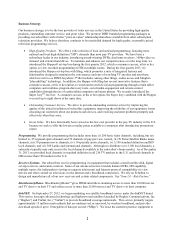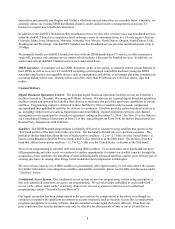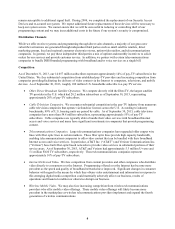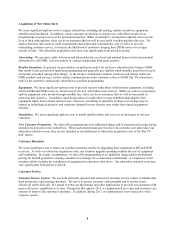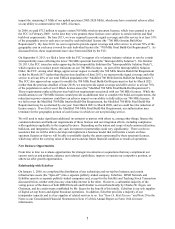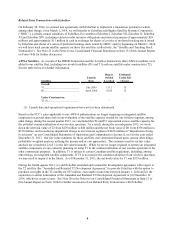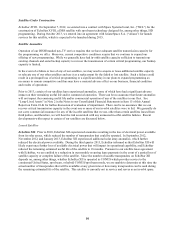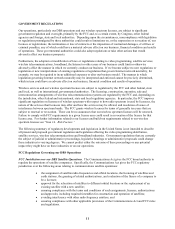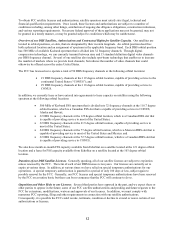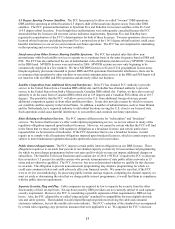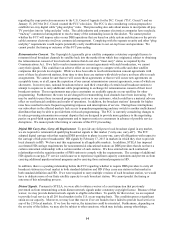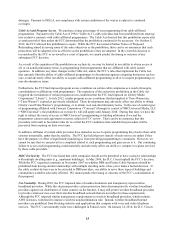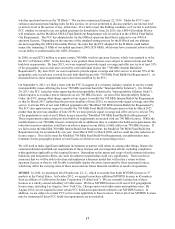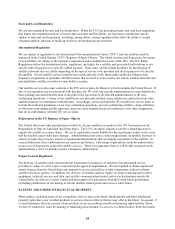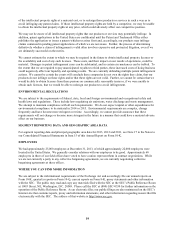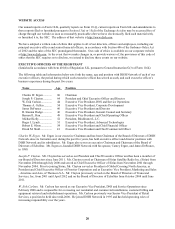Dish Network 2013 Annual Report Download - page 20
Download and view the complete annual report
Please find page 20 of the 2013 Dish Network annual report below. You can navigate through the pages in the report by either clicking on the pages listed below, or by using the keyword search tool below to find specific information within the annual report.
10
10
Satellites Under Construction
EchoStar XVIII. On September 7, 2012, we entered into a contract with Space Systems/Loral, Inc. (“SS/L”) for the
construction of EchoStar XVIII, a DBS satellite with spot beam technology designed for, among other things, HD
programming. During October 2013, we entered into an agreement with ArianeSpace S.A. (“Ariane”) for launch
services for this satellite, which is expected to be launched during 2015.
Satellite Anomalies
Operation of our DISH branded pay-TV service requires that we have adequate satellite transmission capacity for
the programming we offer. Moreover, current competitive conditions require that we continue to expand our
offering of new programming. While we generally have had in-orbit satellite capacity sufficient to transmit our
existing channels and some backup capacity to recover the transmission of certain critical programming, our backup
capacity is limited.
In the event of a failure or loss of any of our satellites, we may need to acquire or lease additional satellite capacity
or relocate one of our other satellites and use it as a replacement for the failed or lost satellite. Such a failure could
result in a prolonged loss of critical programming or a significant delay in our plans to expand programming as
necessary to remain competitive and thus may have a material adverse effect on our business, financial condition
and results of operations.
Prior to 2013, certain of our satellites have experienced anomalies, some of which have had a significant adverse
impact on their remaining useful life and/or commercial operation. There can be no assurance that future anomalies
will not impact the remaining useful life and/or commercial operation of any of the satellites in our fleet. See
“Long-Lived Assets” in Note 2 in the Notes to our Consolidated Financial Statements in Item 15 of this Annual
Report on Form 10-K for further discussion of evaluation of impairment. There can be no assurance that we can
recover critical transmission capacity in the event one or more of our in-orbit satellites were to fail. We generally do
not carry commercial insurance for any of the in-orbit satellites that we use, other than certain satellites leased from
third parties, and therefore, we will bear the risk associated with any uninsured in-orbit satellite failures. Recent
developments with respect to certain of our satellites are discussed below.
Leased Satellites
EchoStar XII. Prior to 2010, EchoStar XII experienced anomalies resulting in the loss of electrical power available
from its solar arrays, which reduced the number of transponders that could be operated. In September 2012,
November 2012, and January 2013, EchoStar XII experienced additional solar array anomalies, which further
reduced the electrical power available. During the third quarter 2013, EchoStar informed us that EchoStar XII will
likely experience further loss of available electrical power that will impact its operational capability, and EchoStar
reduced the remaining estimated useful life of the satellite to 18 months. Pursuant to our satellite lease agreement
with EchoStar, we are entitled to a reduction in our monthly recurring lease payments in the event of a partial loss of
satellite capacity or complete failure of the satellite. Since the number of useable transponders on EchoStar XII
depends on, among other things, whether EchoStar XII is operated in CONUS which provides service to the
continental United States, spot beam, or hybrid CONUS/spot beam mode, we are unable to determine at this time the
actual number of transponders that will be available at any given time or how many transponders can be used during
the remaining estimated life of the satellite. This satellite is currently not in service and serves as an in-orbit spare.



